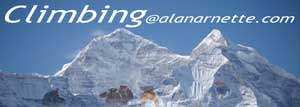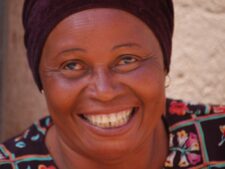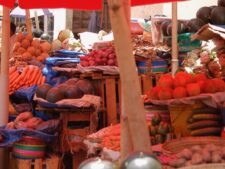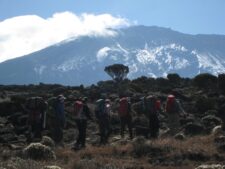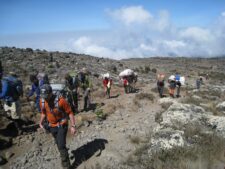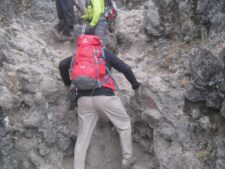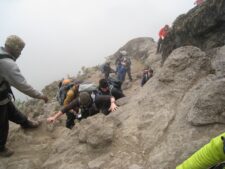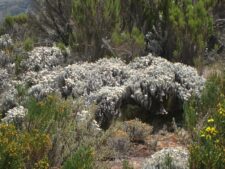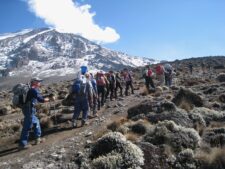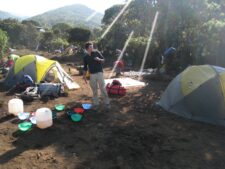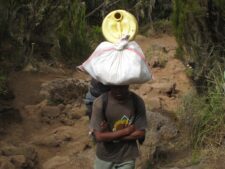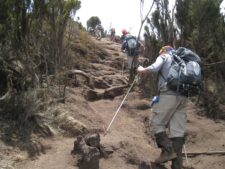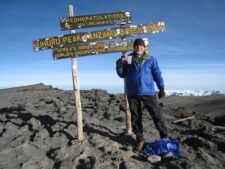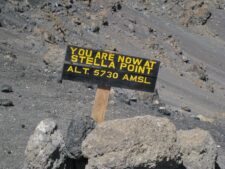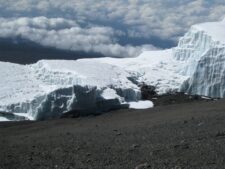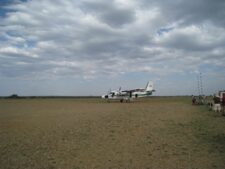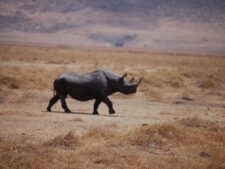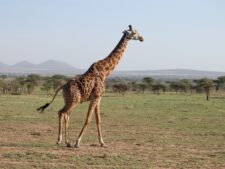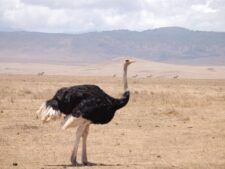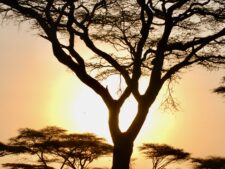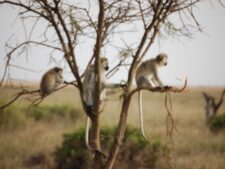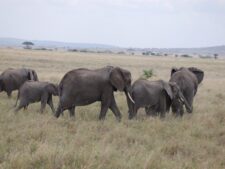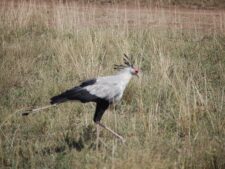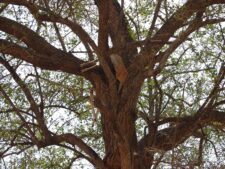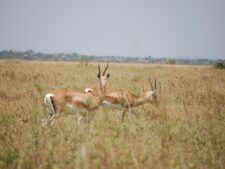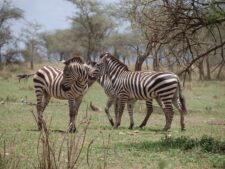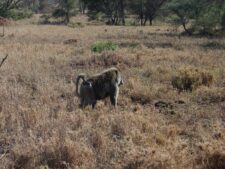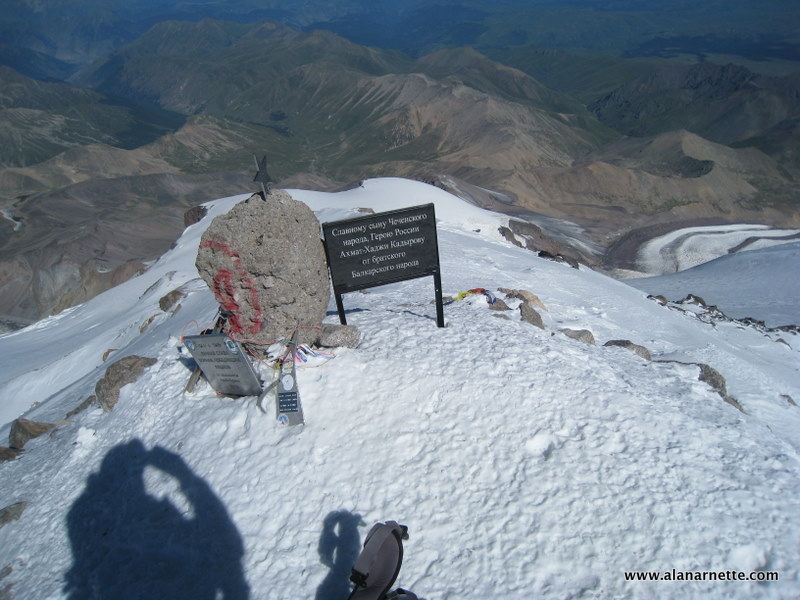Of all the Seven Summits, Kilimanjaro offers a two-for kind of “climb.” Well, to be accurate, it’s more of a trek to 20,000 feet and a safari for those wanting more Africa. The experiences are a cultural treat made special by everyone you meet in restaurants and hotels, not to mention the guides, porters and safari leaders. It is a must-do for anyone seeking adventure and global education.
Overview
Kili is among the world’s highest volcanoes at 19,340 feet / 5894 meters. The highest is Ojos del Salado, at 22,615 feet/ 6893 meters on the Argentina/Chile border. German Hans Meyer first summited Kili in 1889. The volcano has three peaks: Kibo, Shira and Mawenzi, with Kibo being the summit.
Many climbers consider it a walk-up, but it still represents a deadly threat when climbers go too fast or ignore challenging weather. The local park officials maintain strict rules and require local guides to accompany each team. The climb takes four to seven days, with seven being the suggested minimum time, with eight or nine even better, to allow for proper acclimatization. Tent camping is the standard on all routes. Porters carry most of the group gear, so climbers usually just manage a small day pack, weighing 10 and 15 pounds.
Of note, the Kilimanjaro Porters Assistance Project (KPAP) encourages climbers and visitors to support the Kili porters by donating clothes, but more importantly, it monitors operators regarding the fair treatment of all porters, including pay, health, insurance and gear.
Kilimanjaro is the closest of the seven to the equator, so January, February and July through October will offer the best weather. March, April, and November are the rainy months.
The second highest mountain in Africa is Mt. Kenya in Kenya, at 17,057’/5199m, 250 miles north of Kilimanjaro.
Logistics and Difficulty
Kili is a straightforward climb via the regular routes with no real objective danger except for cold summit weather. Porters carry everything for you, as the park regulations require, so all you have is a simple day pack with the bare essentials. The routes are very dry, and there is rarely snow at lower elevations but some snow on the summit. There is no crevasse danger like on Denali or Rainier, and it’s similar to a Colorado 14er (albeit higher) than Rainier or Denali.
Most people find it manageable on a perfect weather day and regular routes. However, as with most extreme altitude climbs, Kilimanjaro can have brutal summit weather with temperatures at 0F. When the winds blow, the wind chills can be very dangerous. Climbers have died on Kilimanjaro. Also, remember that this is almost 6,000 meters or 20,000 feet, so AMS is always a risk, as is HAPE or HACE.
It is estimated that 25,000 climb Kilimanjaro using the various routes each year. The summit rate is around 66%, with cold summit days and altitude issues being the primary reasons for not summiting. There is about one death each year, and is relatively safe; however, one climber was killed by lightning in early 2013
Routes and Dangers
While multiple routes exist on the mountain, several dominate. The climb is relatively tame compared to others, like Denali’s physicality, Carstensz’s technical climbing and Everest’s altitude. Five main routes meander through the jungle, crossing five microclimates to join the three final ascent routes to Kibo.
Both the Machame and Lemosho routes offer a more leisurely-paced scenic climb. The Lemosho route is less crowded, while the Machame route has a more difficult beginning but joins into the same route as the Lemosho. The Marangu, aka Coco-cola route, is crowded since it follows a road part-way. It also offers a hut instead of sleeping in tents, but I’m not sure that’s advantageous given the conditions. The Northern Circuit is relatively new, and I think it’s a winner. It is a bit longer, which is good for acclimatization, but it is still very scenic and less crowded.
“Climbing”
My climb was more of a hike at a high altitude. I did the Machame route, which starts in the jungle at 10,000 feet / 3048 meters and goes through five microclimates to the summit. The trail was smooth primarily and well-worn. There was a bit of mud initially, so I appreciated having gators. Depending on your experience, the most “challenging” section was on the Baranco Wall, where we did some easy rock scrambling. Otherwise, the entire route to the summit and down was straightforward and similar to a Colorado 14er.
Safari
One of the all-time treats was going on an African safari. After our Kili climb, we took a short bush plane ride to the Serengeti. Landing on a grass strip, we were immediately greeted by a wild buffalo herd. I finally saw many animals I admired on television or in magazines. We went to the Ngorongoro Crater, the world’s largest – a previously collapsed volcano- and saw many more animals, including the rare Black Rhino, of which only 3,000 are in the wild. The safari guide was knowledgeable, explaining in detail what we saw and was happy to answer our questions.
Summary
Kilimanjaro is a fun cultural experience, but I enjoyed the safari more afterward. I would return for both the climb and the safari.
If you want to cover all the Seven Summits angles, here is the list of nine climbs:
- Everest, Nepal – 29,035/8850m
- Aconcagua, Argentina – 22,902/6960m
- Denali, Alaska – 20,320/6194m
- Kilimanjaro, Africa – 19,340/5896m
- Elbrus, Russia – 18,513/5642m
- Vinson, Antarctica – 16,067/4897m
- Carstensz Pyramid (Puncak Jaya), New Guinea – 16,023/4884m
- Mt. Blanc, France/Italy – 15,771’/4807m
- Mt. Kościuszko, Australia – 7,310/2228m
Episodes will drop each week:
- September 15: Introduction
- September 22: Mt. Kościuszko, Australia – 7,310/2228m
- September 29: Mt. Blanc, France/Italy – 15,771’/4807m
- October 6: Vinson, Antarctica – 16,067/4897m
- October 13: Carstensz Pyramid (Puncak Jaya), New Guinea – 16,023/4884m
- October 20: Elbrus, Russia – 18,513/5642m
- October 27: Kilimanjaro, Africa – 19,340/5896m
- November 3: Denali, Alaska – 20,320/6194m
- November 10: Aconcagua, Argentina – 22,902/6960m
- November 17: Everest, Nepal/Tibet – 29,035/8850m
Safe climbing to all.
Climb On!
Alan
Memories are Everything
Video podcast version of Episode 7: Seven Summits: Kilimanjaro
You can listen to my podcasts on Spotify, Apple Podcast, Google Podcasts, Pocket Casts, RadioPublic, Anchor, and more. Just search for “Alan Arnette” on your favorite podcast platform.
Summit Coach
 If you dream of climbing mountains but are unsure how to start or reach your next level, from a Colorado 14er to Rainier, Everest, or even K2, we can help. Summit Coach is a consulting service that helps aspiring climbers throughout the world achieve their goals through a personalized set of consulting services based on Alan Arnette’s 25 years of high-altitude mountain experience, including summits of Everest, K2, and Manaslu, and 30 years as a business executive.
If you dream of climbing mountains but are unsure how to start or reach your next level, from a Colorado 14er to Rainier, Everest, or even K2, we can help. Summit Coach is a consulting service that helps aspiring climbers throughout the world achieve their goals through a personalized set of consulting services based on Alan Arnette’s 25 years of high-altitude mountain experience, including summits of Everest, K2, and Manaslu, and 30 years as a business executive.
